Coro
Fast learner! (no pato mareado!) Just extend the outside leg more when carving.
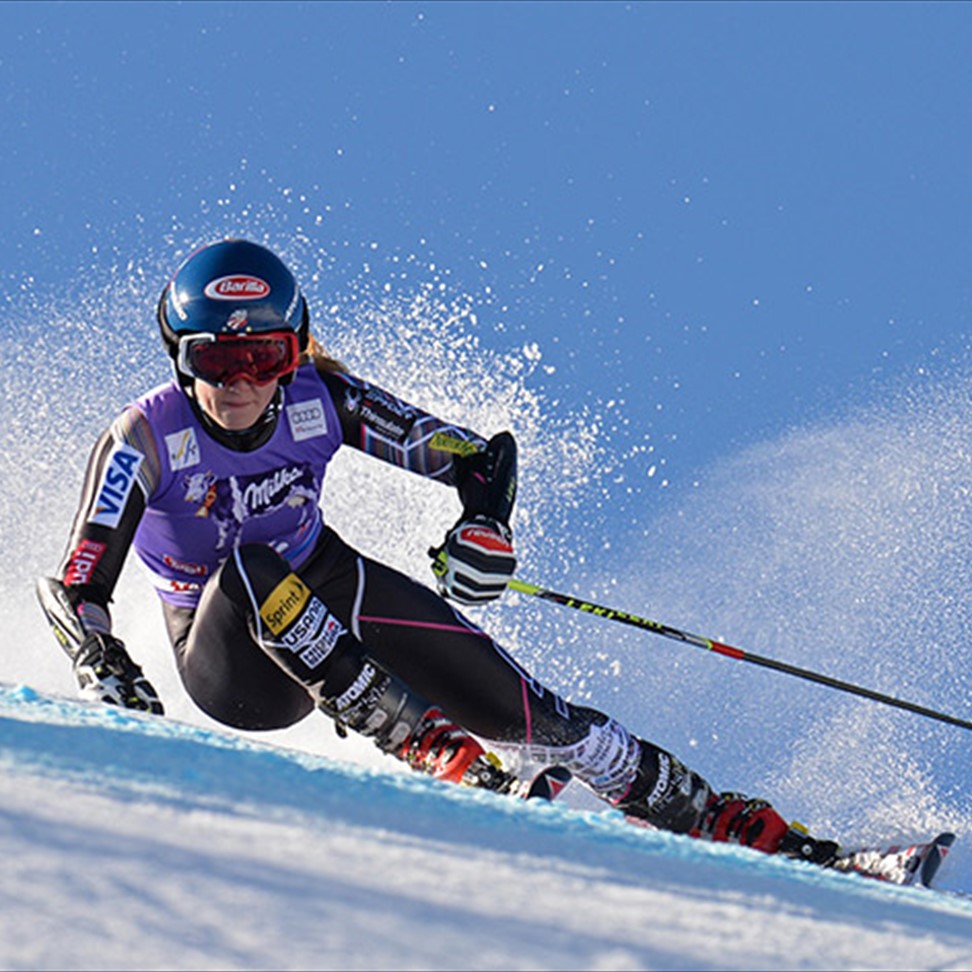
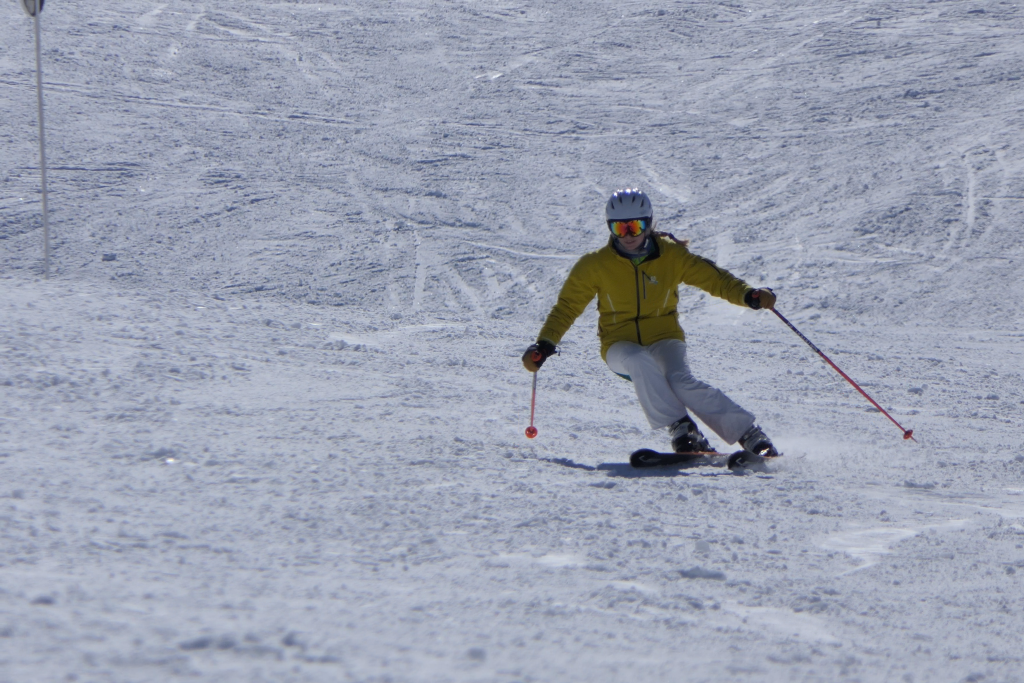
Tom
Strong skier – work on hip angulation!
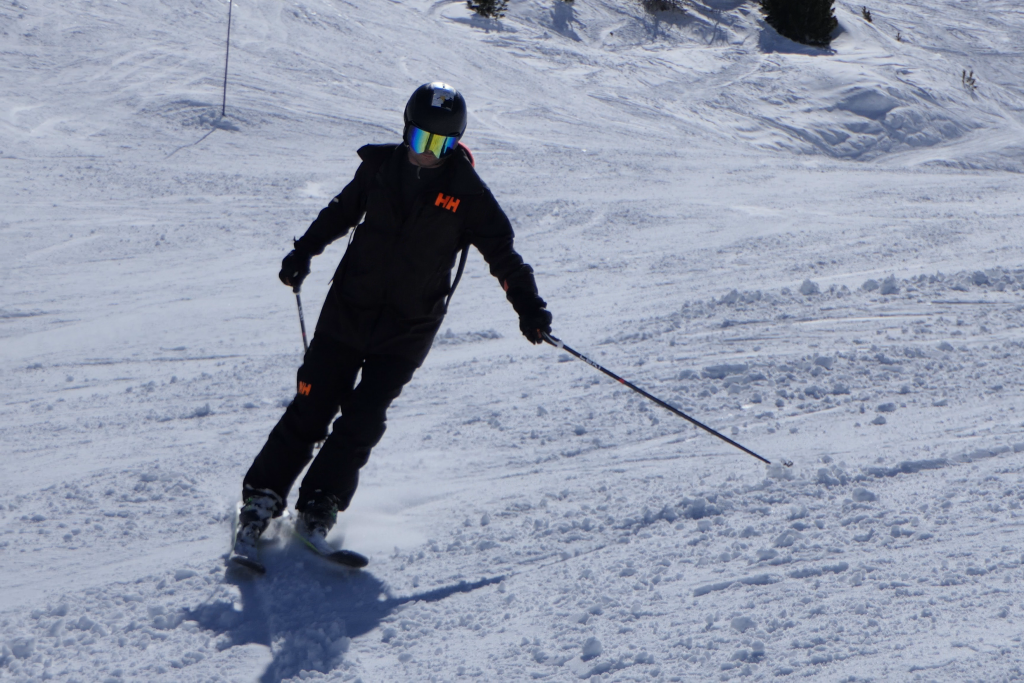
- Basic Dynamics
- Body Management/Hip Angulation
- Pivoting
- Advanced Dynamics (Leg Retraction, Compression Turns, Hanger Turns)
Basic Dynamics (skis parallel)
- Skis must be travelling forward – like a bicycle
- This is mainly about using the outside leg (start of new turn) to push the centre of mass into the centre of the new turn – for the whole duration of the turn
- There is no “balance” when skiing – dynamics is the physics of disequilibrium
- You are looking for stability from organised accelerations (ski technology!)
- Notice in the photos below the outside leg is essentially straight in a skating action (flexion for absorption and other purposes is primarily at the hip joint)
- The centre of mass goes down toward the snow – and to complete the turn it comes back up – like a motorbike in a turn
- There is no “Centrifugal Force” acting on the skier – only a deflection inward away from a straight line. This deflection is used to lift the skier up at the end of the turn – which involves “finishing” the turn – I.E. turning almost back up the hill.
- Remain square to the skis (follow the skis around the turn with your body) until you are really comfortable with movement of the centre of mass and clearly aware of moving it.
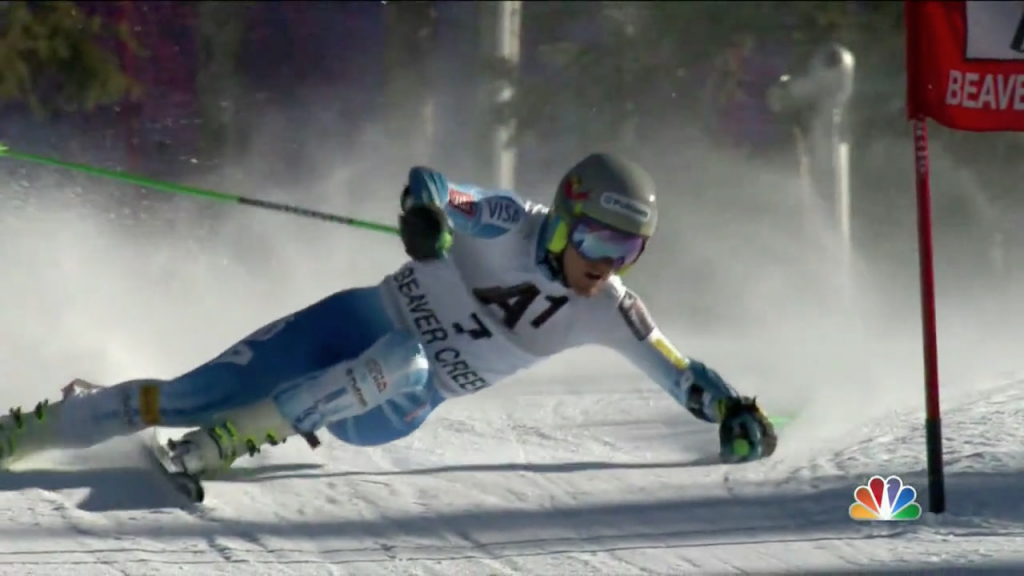
Body Management (Hip Angulation)
Take a look at the two Olympic champion skiers in the photograph below.
Killy’s image from the 1960s has his chest facing downhill whereas Noel’s image from 2022 has his chest facing forward. What Killy is doing destroys your lower back and is probably why he never went on skis again after he stopped racing.

Protecting the Spine
- Hold the front of the pelvis up – aiming for “neutral pelvis”
- During the turn pull the outer hip backwards so that the ski doesn’t pull it in front of your ribs
- Look for a stretch between the ribs and hip joint
- Look for a reflex contraction of the lower abdominals – the postural reflex
- Keep the shoulders/chest following the skis (to some degree)
- Always “counter turn” the pelvis more than the chest/shoulders (It’s only the pelvis that should “face downhill”)
- Pulling the hip backwards also prevents both hip rotation and full upper body rotation
Source of Hip Angulation
The upper body needs to tilt forward over one hip joint – then rotate around it. This is in addition to pulling back the outside hip etc.
The body shape produced alters the location of the centre of mass enabling pressure on the ski fronts and also greater agility both into and out of turns – and pole planting if the skis are swinging laterally.
The hip angulation also provides flexion of the hip joint that gives absorption of shocks. Increased angulation also increases the edge angle of the skis to the snow and may alter the turn radius and grip.
Angulation when upright and pivoting has another function – when ANTICIPATING the next turn it is used to get the Centre of Mass out of the existing turn (by tilting the torso forward at the hip ) and letting the Centre of Mass move over the skis to plant the ski pole downhill for a strong, clear and definite support.
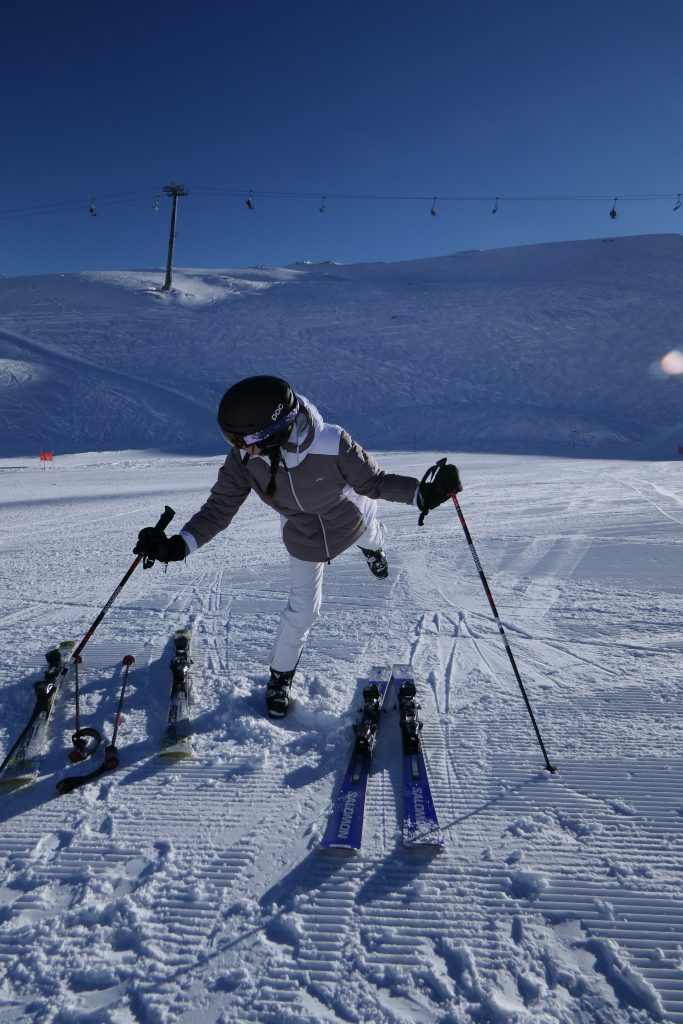
When the entire body inclines into the turn with hip angulation present this below is what it looks like.

Side Slipping (Centre of Mass)
The main practical purpose of sideslipping is to get down the mountain without picking up speed. Many learners are deprived of this skill because it is generally undervalued and has become even more neglected due to the complete domination of carving skis. Wider skis are easier for sideslipping in a greater range of conditions. Parabolic skis have some trouble gripping on ice during a sideslip, but modern “double rocker” off-piste skis give a smooth and grippy sideslip in just about every condition, including ice.
The skis are kept on edge by the lateral stiffness of the ski boot shafts. Skis over 100mm wide underfoot begin to create problems on hard snow due to the extra leverage from the edge through the shaft of the boot. Those skis can be very unpleasant on-piste and it’s one limit of how an “all round” ski can be defined. Anything wider than 100mm is not “all round”. In ski teaching the sideslip serves specifically for developing fall-line skiing. Fall-line skiing is where the skier’s body travels directly downhill and not across the hill. This would apply to bumps, steep off-piste such as couloirs and deep powder snow. Slalom is not “fall-line” skiing. The skier should be able to sideslip on either ski or both at the same time. It’s normal to start off with both skis on the snow, skis parallel and with the majority of weight on the lower ski just to get a feel for it. The stance is normally quite narrow to prevent the uphill ski from catching the lower edge. Most beginners have trouble keeping the skis close together.
It should be noticed that only the uphill edges of the skis are in contact with the snow so the downhill edges are in the air. If the fronts of the skis are pushed downhill (Joystick Control – moving the Centre of Mass forward) then there will be no resistance from the downhill edges and so the skier goes into a forward diagonal sideslip. Likewise if the tails are pushed downwards during the sideslip then it turns into a backwards diagonal sideslip. Being able to alternate between straight down the fall-line and the two diagonals is a precursor to the skill necessary for pivoting in the fall-line. Both legs need to squeeze the adductor muscles together – holding the upper legs close together. Pulling both legs together keeps a narrow stance and when the skier practices sideslipping on one leg it ensures the that the geometry of the edge angles to the slope are optimum for pivoting.
Pivot (Skis sliding Sideways)
Pivoting is derived from the skis sliding sideways and can be developed from side slipping (It’s a braking form of turning). With a “pure pivot” as an exercise there is no forward travelling of the ski across the hill. Support for the centre of mass is now provided by support from a downhill pole plant. This is the real reason why we have ski poles! There is a full dedicated explanation of pivoting at the following link: “PIVOT“
Combining Dynamics and Pivot
- Dynamics depends of forward motion of the skis and lateral falling/pushing of the centre of mass
- Pivot depends on lateral motion of the skis – but always with the centre of mass being driven inward (toward the turn centre) modulated by the support of a pole plant
- The two can be combined – when there is both forward and lateral motion – making overall control of trajectory and speed totally under control of the skier
- In all cases there must be active adductor muscle use – and the feet must be “everted” i.e. turned outward inside the ski boots – diverging sightly (skating stance)
- The essential element to take from combining pivot and dynamics is to execute the turn transition from the uphill edge of the uphill ski – noting that the ski enters the new turn more easily than when on its inside edge and this also prevents stemming (and body rotation)
- Additionally with the transition between the two turns being made from the uphill edge it’s easy to switch into a very tight pivot when desired
Look at the skis in the two images below. The top image is with skis carving – the bottom image skis pivoting
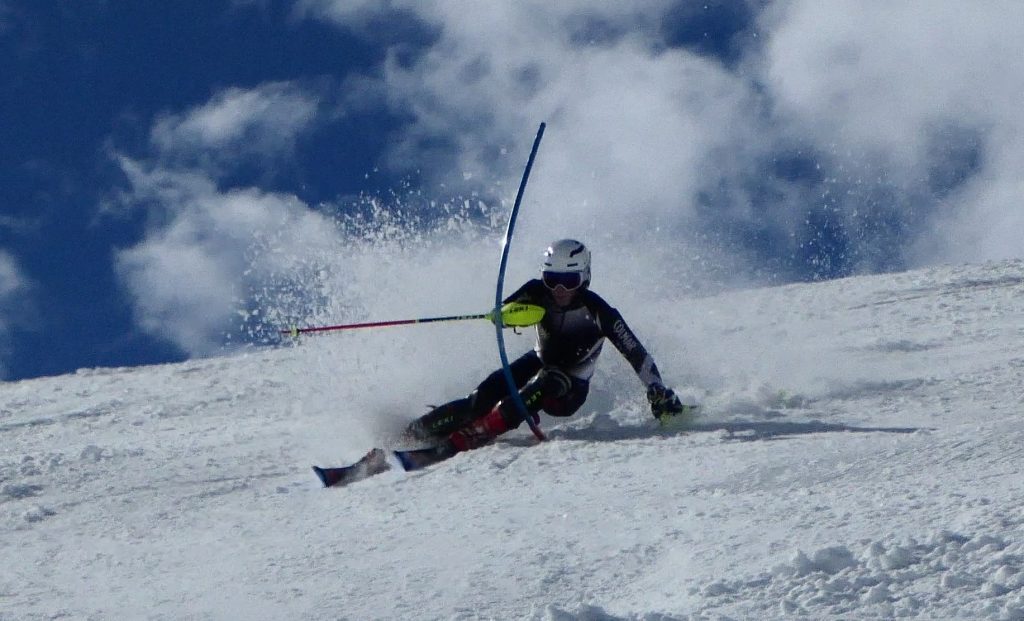

Advanced Dynamics
Compression Turns
Here’s a useful video showing proper compression turns at an advanced level. (Warning! – The drills used to “teach” in the clip are mainly inappropriate and fail to show the pivoting nature of bump skiing. However the advanced dynamics used by the demonstrators are correct.)
Leg Retraction
“Leg retraction” – the extended downhill leg at the end of a turn is retracted to allow the body to cross over the skis into the next turn the fastest way possible – then the new outside leg extends (independent leg action). The video below shows a top World Cup racer using this movement pattern. It’s easier to learn this pattern first and apply it to “normal” skiing before learning how to retract both legs simultaneously with the feet together to absorb bumps.
Hanger Turns
While leg retraction is the fastest way to get the body across the skis from one turn to the next sometimes instead it is necessary or preferable to direct the body across the hill – where using the downhill ski to complete the turn then becomes desirable.
Visualize a motorbike going into a turn and coming down low to the ground then back up out of the turn to complete it. Then visualize doing all of that on the outside ski of a single turn on skis – letting the ski lift the body up and out of the turn and finishing going across the slope with the skis now flat on the surface. Sometimes the entire turn transition into the next turn can also be carried out on this downhill ski – this being named a “Hanger Turn”. Basically this entails a complete commitment of the centre of mass directed laterally to the skis and downhill.

